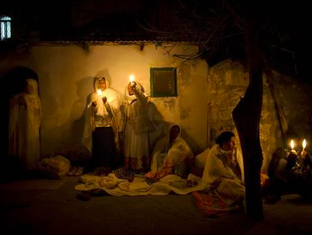 It’s not what you think. I am not speaking about church folk being addicted to porn or anything like that. In fact, I am not writing here about sexually explicit porn. Nonetheless, to be frank, I am concerned about something less obvious, as harmful, maybe even more dangerous. Especially to the church. We seem to know the common definitions of the words “porn” or “pornography” as images of sensuousness, sexuality, and sex. Interestingly, there is a definition that puts porn/pornography on a whole deferent level beyond the easy to identify “sexual porn.” Merriam-Webster also defines “porn” as the “depiction of acts in a sensational manner so as to arouse a quick intense emotional reaction.” Most immediately pivot to the sexual implications. However, while that can—as it should—definitely be understood to be the sexual nature most associated with porn/pornography, this definition makes it possible that more than sex can be in the arena of porn. In fact anything “emphasizing the sensuous or sensational aspects of even a nonsexual subject and stimulating a compulsive interest from their audience” is, well, porn. Here I’d like to focus our attention on what I will call “church porn.” I am borrowing from the so-called image-based sexual revolution that has been afoot since 1916, when ladies began displaying knee-high bathing suits above the ankles and men showed off their muscle-building on the beach to display their fit bodies for public consumption. (And you thought it was a sixties thing.) It’s taken decades, but the sexual revolution has created everyday habits and associations that form the way you and I think, literally about everything. As teenage boys (and sadly, girls, as well), by the time they are young adults, are exposed to thousands of hours of sexual imagery (explicit and soft and suggestive), mostly depicting that women are there to meet their needs and pleasure, the same is also true of those entering ministry. Here I am not just focused on sexual porn, but the porn of success, images of desire and expectations that have formed a whole narrative about the world and how it works. This has created sensational and, yes, sensuous feelings, expectations, and imaginations in those training for ministry, who will be praying and seeking for “a call,” and, as well, those simply picking a church and looking to meet his/her (or family) needs—informed and shaped needs created by those thousands of hours of exposure. As individuals seek “God’s will,” they have been, already, exposed to hours of imagery of what will meet one’s needs, bring success, and be affirmed by one’s felt peer group. These thousands of images have shaped the imagination of what that “call” or church should look like. This is the porn that is molding the expectations of both their choice of a church and “the call” one feels when looking for a pastoral call, a potential place of ministry (lay or pastoral), or simply “being led” to a choice of church to attend. This is a problem. A problem for the church. A problem for churches that don’t stimulate that compulsive interest that has been embedded into us, culturally, socially, or personally. This type of porn is not obvious, but it is ubiquitous. This type of porn is everywhere, in advertisement, in TV shows, movies, social media . . . heck, it is even used in advertising one’s church or church event. We are at a place where we should, as Supreme Court Potter Stewart said of obscenity itself in 1964, “I know it when I see it.” We know this cultural and social image-based porn is bombarding us. We should. But do we? Perhaps, somehow, we feel, as Christians, as mature Christians, we are above this ubiquitous sensual bombardment of cultural and social images and free to let God be God in our thinking, especially as it relates to church or a call to ministry. We are not. And, that’s a problem. This cultural and social porn is not even considered as a factor that plays a role in our decision-making process as we consider a call to ministry or what church to choose. Mostly, that call or that church has been chosen for us—we just don’t know it—of course, we’ll affirm we’ve been led by God in that choice. Yet, there is a good chance that God has not. Church porn has. In part 2, I will address how such church porn, the amassed thousands of embedded cultural and social images we are inundated with, molds what we think is God’s leading when it comes to “the call to ministry” or simply choosing a church to attend. In part 3, I will offer a counterstory as a path of recovery from addiction to church porn.
0 Comments
 Many Christian advocates for social justice cry out for deconstructing privilege and the privileged from a platform of privilege themselves, a place of power, celebrity, notoriety, and/or money (not to exclude address, i.e., where they live and the resources at their disposal). Over and over, their advocacy seems to contradict their status and lifestyle. These same advocates for social justice use the Bible (and for the most part I align and, even, agree with much of their message; not so much their means, which are, for the most part, not biblical, but mostly cultural, political, and status resourced). Here’s what strikes me: The original advocacy (i.e., the gospel of Jesus, the Messiah) and how it changed things, how it deconstructed, and, then, reconstructed habits and lives and attitudes did not occur from the place of power, but from the place of powerlessness. We learn this, first, from the humanizing (i.e., incarnation) of the One who was in the form of God from all eternity taking on the form of a slave (Phil 2); and, second, from the small gatherings of believers in homes (living rooms), we now call churches, made up mostly of the poor and powerless in the early decades of the church. Of course, there were some wealthy among them and some who provided homes for churches to gather; yet, here, too, as Christians and people that used their homes for believers to gather would have lost their status and social standing (at least in part), leaving them to be classed among the powerless and the bottom-demographics of the Roman Empire and Greek world. It would be nearly three centuries before the wealthy, educated, and powerful had control over the affairs of the church. No longer in homes. State (i.e., Empire) sanctioned and often constructed buildings became the addressed-venues of churches. Highly trained and Empire sanctioned clergy had authority over the church. No longer food for a supper, but tokens of bread and wine were used and guarded and distributed by this now elite, often cosmopolitan, clergy. Now, the State (or Empire) controlled the advocacy, that is the results of the gospel. The poor and the powerless among the Christians were separated from their more wealthy, educated, and affluent Christian brothers and sisters, by design and by default. Yet, it was not so in the beginning and for about 300 years of church history. Obviously the shift crept in, but was not fully established until the Emperor “converted” (but was not baptized) and the Empire started creating a space of power for the leaders of the church. My concern here is not to dwell on how the church came to know power and has been able to produce power and the powerful, but to highlight that our present social justice advocates do so from a platform of power that the very gods of empire (call it as you will, colonialism, Christendom, American upward mobility—no matter, it is the powers that) has given (such power) to them. Few seem to divest themselves of power and privilege (as did Jesus, whom they say they follow) and take on the form of a slave and being obedient to the point of death, even death (i.e., dying to self) on a cross (again, cf. Phil 2) on which they are called to carry; but, yet, offer, still, their justice rhetoric and (really what is often simply) political vision from a place of culturally designed privilege and power. Until this is recognized (and deconstructed I might add), such advocacy will rely on the power of the State to enforce their vision (no matter how clothed in biblical language it might be). It is my humble opinion that we need to rethink church, especially as the place where systemic change happens, even though it is a place (and the space) of the poor and powerless. (Well, it should be.) Of course, plenty of “churches” need repentance, an attitude of lament, and a call back to the gospel (liberal, progressive, and conservative churches), but, nonetheless, it is, still, the church (local churches) where the alternative of God’s kingdom is to be lived (by believers) and observed (by outsiders). (Not “look how we vote” or “look how we protest”; but “look how we live and fellowship as strangers and unequals, as brothers and sisters in Christ, a wholly new family in Christ.”) The church, a church, local churches scatter from street to street, neighborhood to neighborhood, places where strangers and unequals meet over a meal (break bread) and celebrate (raise a cup) that they have no other Lord than the risen Messiah, who sits at the Father’s right hand (their only source of power, which is lived by denying themselves and taking up a cross). Such advocacy should not rest in individuals who have forms of cultural power at their disposal, but an advocacy that stems from a gathered-household of faith. Social justice advocacy should be a lived-church thing (and for that matter, the place of no power, no culturally derived and given power). Social justice is a lived-church advocacy. Our advocacy for social justice, like any of our boasting (our culturally, socially, and economically derived desires, vision, or means of power), needs solely to be first and foremost “in the Lord” and made from a willing place of foolishness. Our social justice advocacy platform, the place where we are “like the scum of the world, the refuse of all things,” this is the place, Jesus’ church, local churches, find themselves and where authentic social justice advocacy has its gospel platform.
And this is why church, that is ecclesiology, is so so important.
I have been wrong on many things theological over the years (e.g., nature of man and nature of sin, God's sovereignty and election, the importance of the Lord's supper, and too many more to be embarrassed over, which I hope I know better now), but the biggest “didn’t get” was “church.” I, like most of us, define “church” by and through our culture, our sociological history (i.e., our story), even my personal story, and my social location as (now don’t get offended, or maybe you should)—my social location as a white, suburbanite, living in America, and a person within a westward marching, European cultural history (story). Really need to rethink church and do so within the context of the biblical story. In 1 Peter 2:9 there are two words we must re-translate (a better nuance based on their actual meanings) in order to get a better sense of Peter’s syntax and meaning, which will offer a fresh and perhaps more accurate (and certainly a more powerful) reading of this wonderful set of defining metaphors of the church. First, I take exaggellō (proclaim) to mean more literally, “message out.” Peter uses a different word than the typical “proclaim” (kēryssō) used elsewhere in the NT from which we get the concept of “preaching.” Exaggellō is made from two words ek (out) and aggellō (I message). The verb, aggellō is from the noun, messenger (aggelos, where we also get "angel" as in the angels were God’s messengers—you get that). So, Peter picks an atypical word so we are allowed to rethink “proclaim” a bit and take his choice a bit more targeted to the idea of “messenger” getting the message “out.” Second, the word “that” (hopōs) that follows the wonderful list of church metaphors is also specific as a conjunction (more nuanced than the English "that" implies). The English “that” here gives the idea of goal . . . i.e., it is the goal or result of being “chosen race, a royal priesthood, a holy nation, a people for his own possession” to proclaim (which in English implies speaking, content, words). The word, hopōs, however, that Peter uses here is more nuanced and gives the sense of “in this manner.” So, here is a fresh reading of this most wonderful verse: "So that in this manner—being God’s own possession as a chosen race, a royal priesthood, a holy nation—you, the gathered-church, are to message the excellencies of him who called you out of darkness into his marvelous light." So in this way, the gathered-church (fulfilling the roles as chosen race, royal priesthood, holy mixed ethnic group) is the message. Literally, as the cliche puts it, the church IS the message.
Now, this is powerful reading of the text and underscores the significance and importance of the presence of the gathered-church in a community. Furthermore, this reading makes more sense of what is to follow regarding suffering as church, living in the Empire as a church (a people), and as a church made up of slaves, masters, wives, and husbands (1 Peter 2:11–17), which all ends with the church as God's apologetic in the world (3:17). Over the last year I have been reflecting on and learning about the failing and cracking of christendom, the structures, privileges, and cultural alignments that allow Christianity to have a central social acceptability and place in our western world. Part of my reading has been on the impossible increase and spread of early Christianity after Acts, the first 300 or so years of church history. A current author, sees a parallel with the exploding Chinese church. Here is his reflection on the Chinese church through the lens of the early church:
|
AuthorChip M. Anderson, advocate for biblical social action; pastor of an urban church plant in the Hill neighborhood of New Haven, CT; husband, father, author, former Greek & NT professor; and, 19 years involved with social action. Archives
February 2024
Categories
All
|
Pages |
More Pages |
|





 RSS Feed
RSS Feed